Radiation CFD Simulation Training Package, 10 Learning Products
$400.00 Student Discount
This CFD training package is prepared for BEGINNER, INTERMEDIATE, and ADVANCED users of ANSYS Fluent software who are interested in the Radiation modules, including 10 practical exercises.
Click on Add To Cart and obtain the Geometry file, Mesh file, and a Comprehensive ANSYS Fluent Training Video.To Order Your Project or benefit from a CFD consultation, contact our experts via email ([email protected]), online support tab, or WhatsApp at +44 7443 197273.
There are some Free Products to check our service quality.
If you want the training video in another language instead of English, ask it via [email protected] after you buy the product.
Description
Radiation, ANSYS Fluent CFD Simulation Training Package, 10 Practical Exercises
The radiation CFD Simulation Training Package is prepared for BEGINNER, INTERMEDIATE, and ADVANCED users of ANSYS Fluent software who are interested in the Radiation modules, including 10 practical exercises. You will learn and obtain comprehensive training on how to simulate projects. The achieved knowledge will enable you to choose the most appropriate modeling approaches and methods for applications and CFD simulations.
Solar Radiation
The solar charge is a type of solar ray tracing as an algorithm for transmitting solar radiation energy, which can only be used for three-dimensional models. In project number 1, the characteristics of solar radiation on surfaces and objects include longitude 36.2605 degrees, latitude 59.6168 degrees, and time zone equivalent to 4.5. In the first case, no cover layer is provided for the gasoline tank, and in the second case, a 0.003 m cover layer is used for the tank’s perimeter.
In project number 2, using the Solar Ray Tracing model, the effects of radiation from the sun in an environment where airflow is established are investigated. In addition, the conduction heat transfer was considered in solid objects. The amount of radiation received was modeled with the geographical characteristics of Baku (The capital of Azerbaijan) at 8 AM and 3 PM on June 21st. The external air velocity was 10 m / s at 27 degrees Celsius. Soil, brick, and wood material specifications were given for land, house, and tree.
Air Ventilation in Radiation CFD Simulation Training Package
Project number 3 simulates the ventilation, air circulation, and heat transfer in a room. The heat is emitted by people, objects, and electrical equipment inside the room. A man, a computer, and two lamps are modeled inside the room; So that man with a density of 985 kg.m-3, a specific heat capacity of 3500 j.kg-1.K-1, and thermal conductivity of 0.5 Wm-1.K-1 are defined.
In project number 4, steady airflow enters the domain from the bottom of the computer room by several inlets and exits the domain from several outlets on the ceiling, considering Radiation heat transfer. This air conditioning method is new and commonly used in office environments. This method provides more energy efficiency since the flow naturally increases due to density difference and buoyancy body force. One of the room’s four main walls is exposed to a constant heat flux equal to 194 W/m2.
In project number 5, heat transfer inside a room and a balcony is e. The balcony has a glass roof and one glass wall. Due to the radiation of sunlight, both room and balcony become warmer and natural convection plays an important role in circulating the flow inside these spaces. The standard k-epsilon model is exploited to solve turbulent flow equations. The P1 solar tracing model simulates the solar rays entering the computational domain. The energy model is activated to calculate the temperature distribution in the domain.
Buildings
Project number 6 simulates the airflow through the space between the two walls of the double façade of the building. To move the airflow upwards in this space based on the density changes caused by the pressure and temperature changes, the boundary condition of the pressure equal to the atmospheric pressure at the inlet and outlet of this space has been used. The main cause of temperature changes in solar energy on the plates of these shells; therefore, the radiation energy model of Discrete Ordinates (DO) and the solar ray tracing model have been used.
Project number 7 simulates the radiation of solar rays into the room’s interior, considering the effects of a wooden partition as solar shading and a double-glazing glass façade. Argon gas has accumulated in the space between the two glasses of the double glazing;
Project number 8 problem simulates the heat transfer inside a mosque. In the present case, it is assumed that heat transfer takes place in two modes of convection and radiation. In fact, the building’s indoor heating source is powered by solar energy, and a heat source is used on the mosque’s ground floor. The heat transfer between the sidewalls of the mosque, the roof of the mosque, and its dome is done with the free airflow of the surrounding environment with a temperature of 309 K and a heat transfer coefficient of 10 W.m-2.K-1.
Solar Collector in Radiation CFD Simulation Training Package
In project number 9, heat transfer in a conical solar collector containing water fluid is simulated and analyzed. The cubic fluid domain consists of an inlet (velocity inlet type, 1m/s) and a pressure outlet. The conical collector consists of an inlet (mass-flow type, 0.0116 Kg/s) and a pressure outlet. The conical solar collector absorbs the sunlight and warms the water inside its tank.
Heat Exchanger
Project number 10 simulates a solar heat exchanger. This system consists of two parts; The water flow moves in the central part of the heat exchanger and the airflow is in the gap installed in the front plate of the heat exchanger. The heat exchanger absorber wall is exposed to solar radiation and absorbs heat through radiant heat transfer. This means that the air gap temperature in front of the absorber plate rises as the sun heats up.
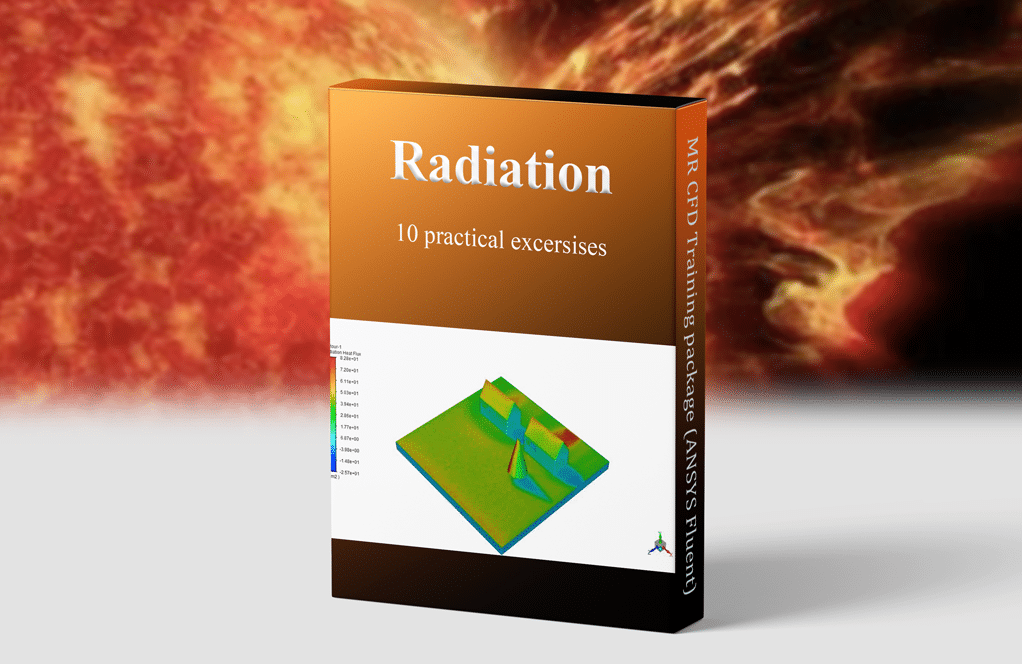


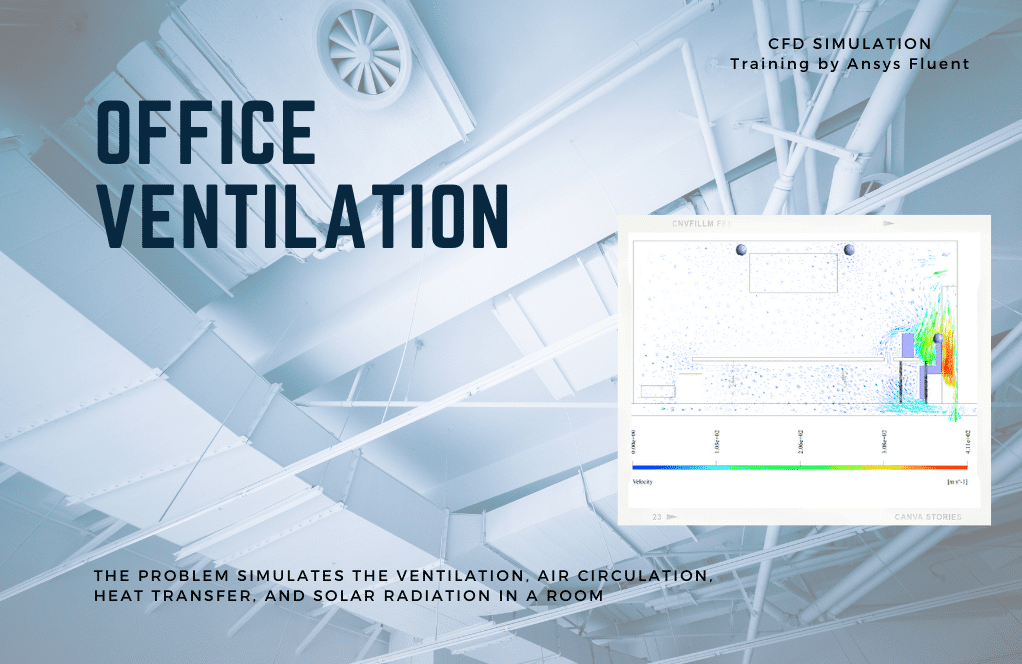
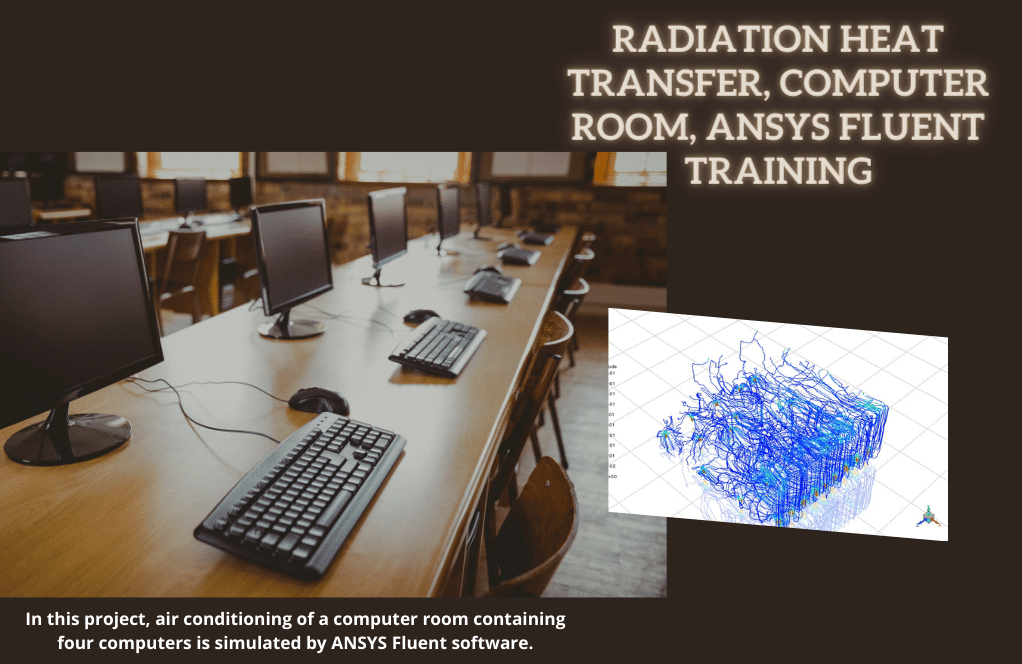
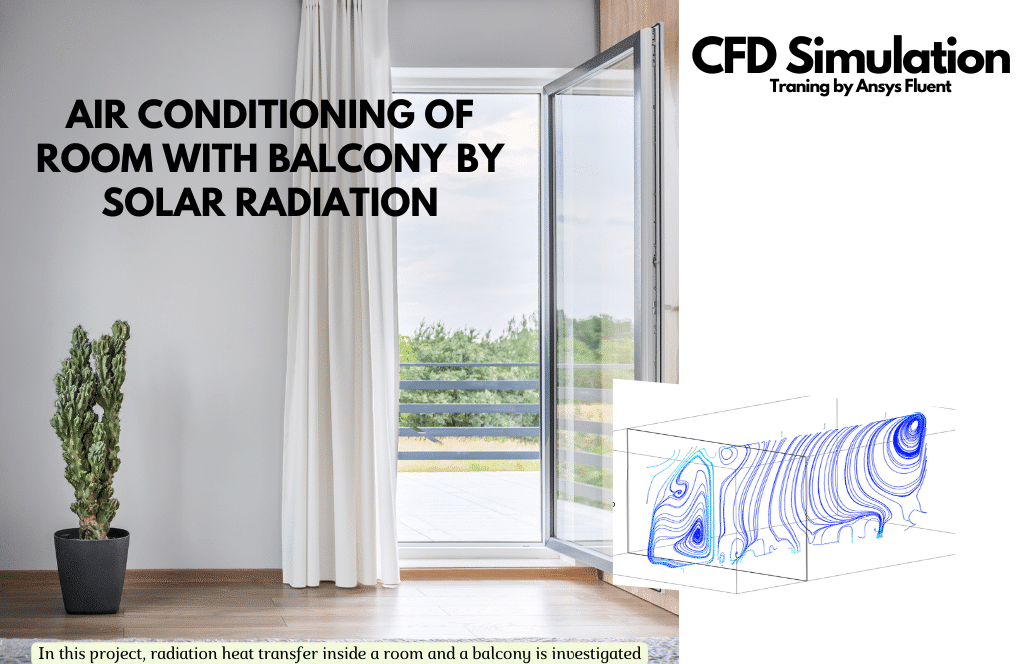
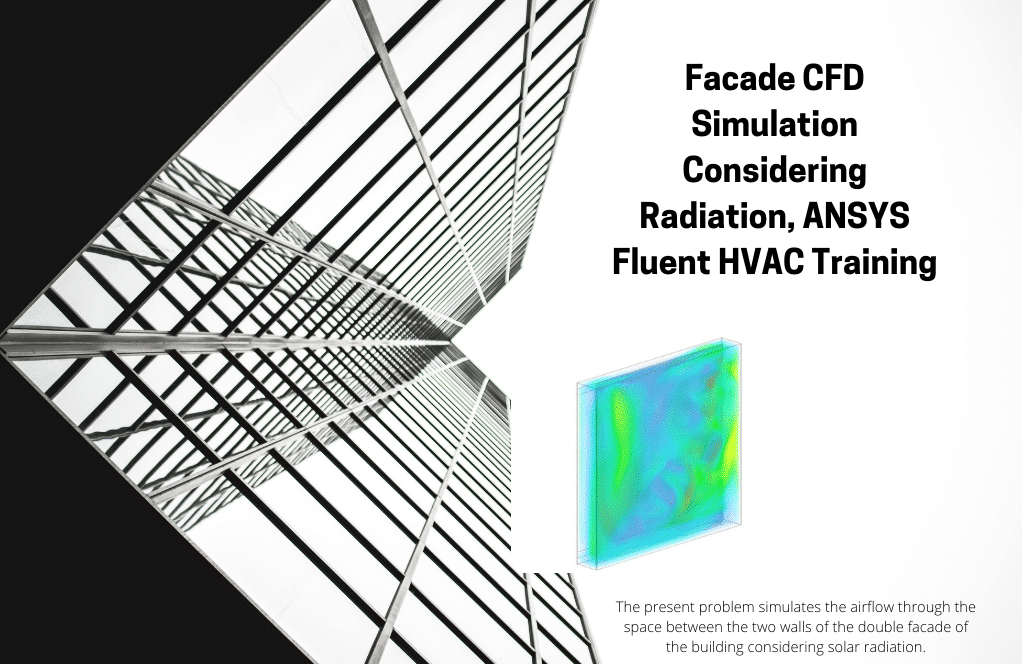
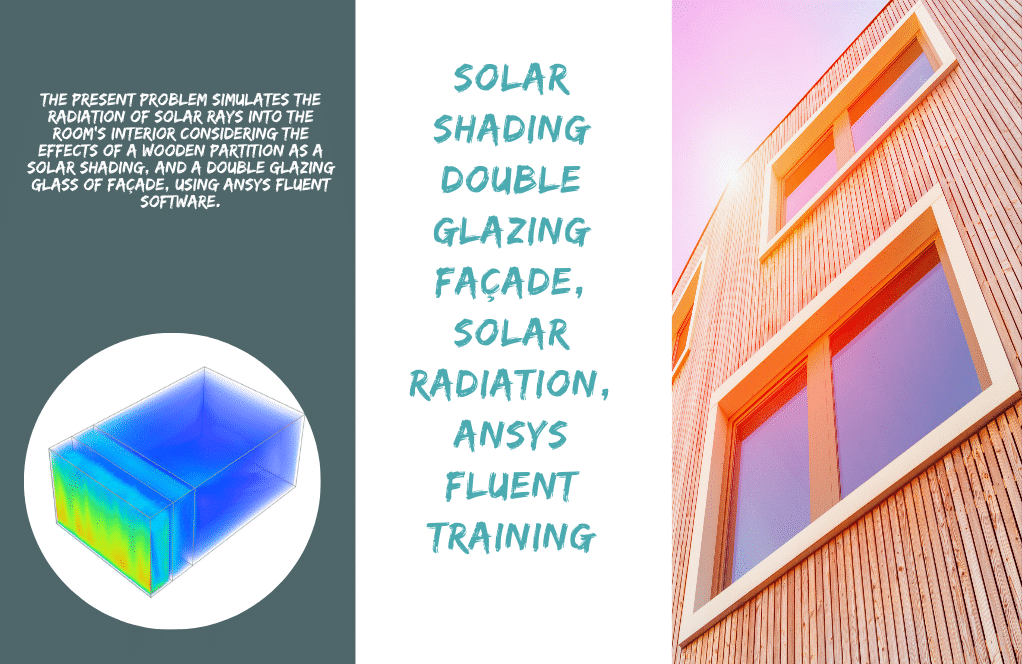
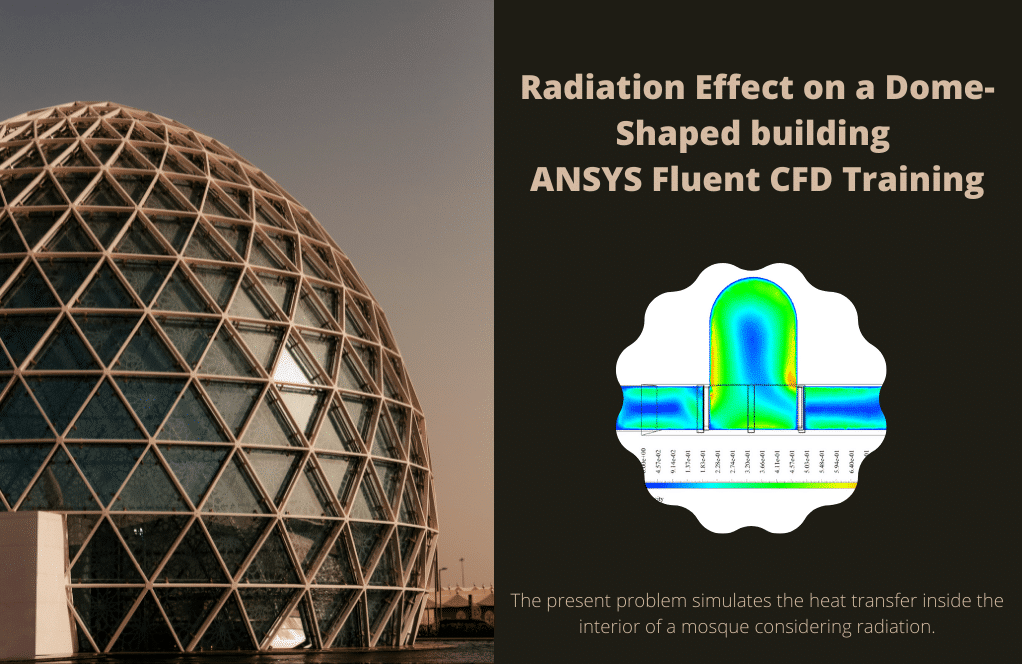
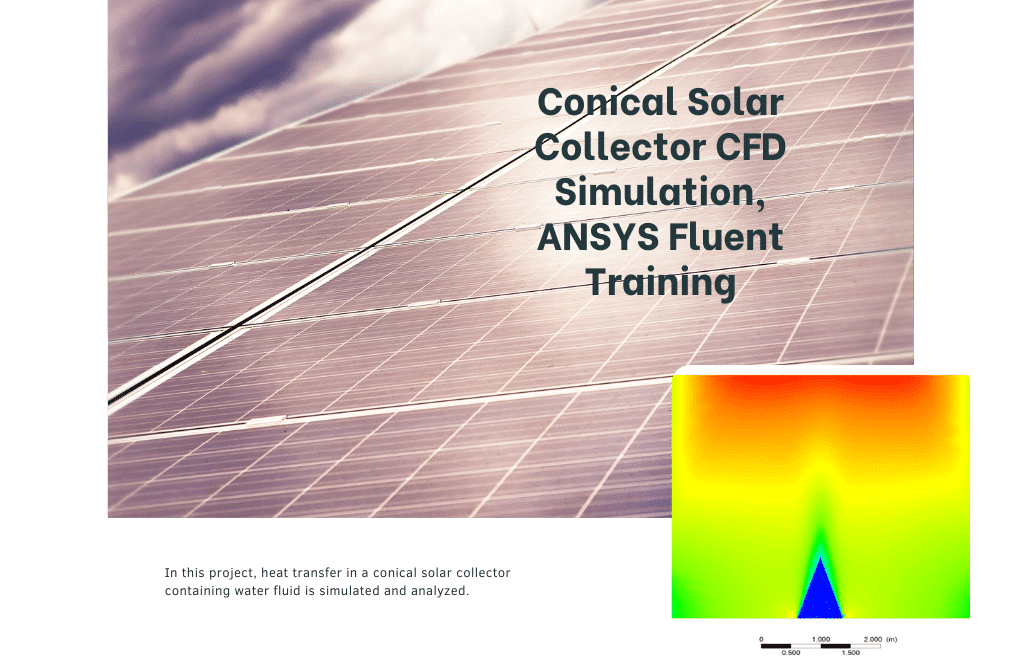
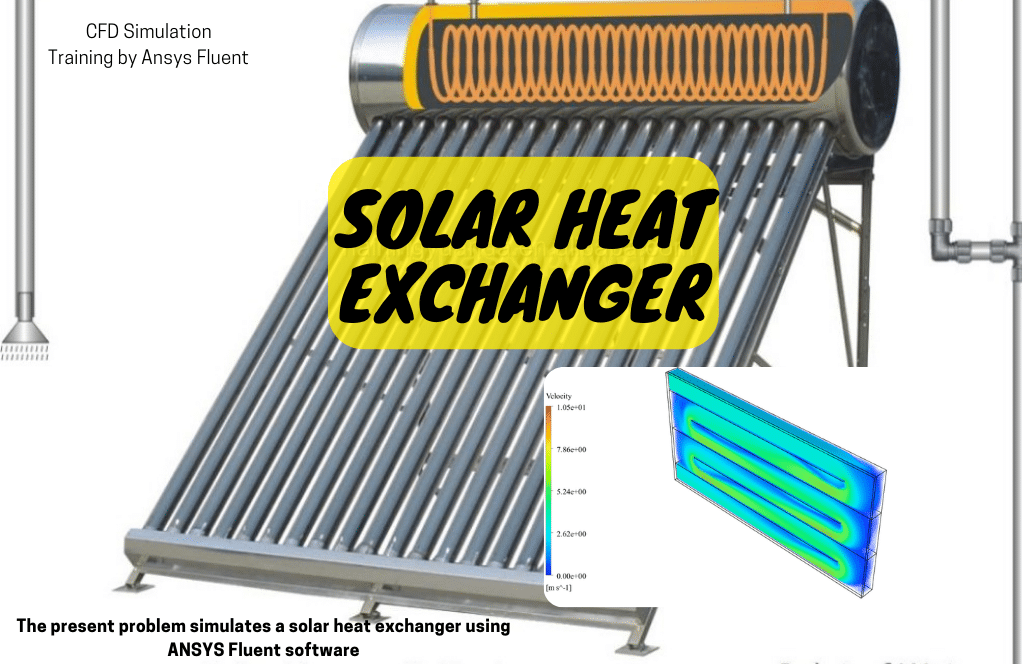
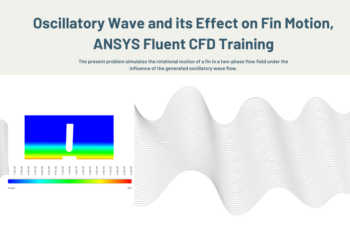
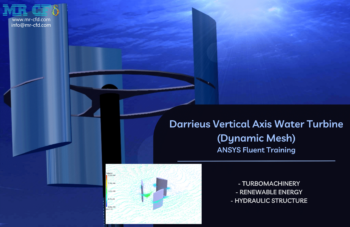
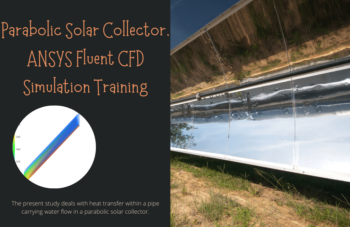

Jarvis White –
I had a wonderful learning experience with the Radiation CFD Simulation Training Package. The exercises were well-designed and guided me through various aspects of radiation modeling in ANSYS Fluent, enhancing my understanding significantly. The variety in projects allowed me to grasp the concepts of solar radiation, air ventilation systems, and heat exchanges in an engaging manner. Truly an invaluable resource for anyone looking to master radiation simulations in CFD.
MR CFD Support –
Thank you for your positive feedback! We are delighted to hear that our Radiation CFD Simulation Training Package has been an invaluable learning tool for you. It’s great to know that the diversity of our projects has helped you enhance your understanding of radiation modeling. We always strive to provide comprehensive and engaging materials, and your appreciation truly motivates us. Should you have any further questions or require additional learning materials, please don’t hesitate to reach out. Happy simulating!
Dashawn Jakubowski –
I recently completed the Radiation CFD Simulation Training Package over several weeks, and I’m truly impressed! Each practical exercise built on the last, firming my understanding of solar ray tracing and energy models. The breath of the ten exercises – from simulating solar collectors to air ventilation – captures a wide range of radiation applications. Huge thanks for providing a training toolbox that boosted not just my skills in using Floric Fluid Dynamics (FD) soltware for radiation modules but also provided a solid grounding in key and physical concepts.
MR CFD Support –
Thank you for your positive feedback on the Radiation CFD Simulation Training Package! We’re thrilled to hear that our learning module provided you with comprehensive training and a deeper understanding of the practical applications of ANSYS Fluent in radiation simulation. Your success is our top priority, and it’s gratifying to know we could contribute to your development in the CFD field. If you have any more questions or need further assistance, feel free to reach out. We wish you the best on your continuous learning journey!
Jordyn Waelchi –
I’ve completed two exercises from the Radiation CFD Simulation Training Package. Are additional support materials or tutorials available if I encounter problems in future exercises?
MR CFD Support –
Yes, additional support materials and tutorials are available for all exercises within the Radiation CFD Simulation Training Package. If you encounter problems or have any questions, you can reach out to our support team, and they will assist you promptly.
Michele Watsica –
The Radiation CFD Simulation Training Package has a great variety of projects. I especially appreciated the detail in the setup for the solar ray tracing scenarios; very informative setups and results!
MR CFD Support –
Thank you for your positive feedback! We’re pleased that you found the Radiation CFD Simulation Training Package comprehensive and informative. It’s great to hear that the detail in the solar ray tracing scenarios met your expectations. Your satisfaction is our top priority. If you have any further insights or need more information, please let us know!
Shawna Kuhlman –
Are all 10 exercises in this package suitable for a beginner, or should a beginner start with a specific exercise first?
MR CFD Support –
While the training package is designed for users with different proficiency levels, we recommend beginners start with exercises and projects specifically tailored for the beginner level. Each exercise will build on the foundational knowledge required for more complex simulations.
Zackery Witting –
This package by MR CFD was truly comprehensive and enhanced my knowledge significantly about radiation modeling in ANSYS Fluent. I appreciated each exercise being targeted at different skill levels and simulation settings, covering a broad scope of real-world scenarios.
MR CFD Support –
Thank you for sharing your positive experience with our Radiation CFD Simulation Training Package. We’re delighted to hear that it has been beneficial to your learning and understanding of radiation modeling in ANSYS Fluent. Should you have any further inquiries or need additional support in your simulations, feel free to reach out to us. We’re here to help you on your CFD journey!
Ms. Maryjane Marquardt –
I really enjoyed the comprehensive material provided in the Radiation CFD Simulation Training Package. The step-by-step approach for performing simulations was extremely helpful. The diversity of projects, from solar collectors to building ventilation, provided a well-rounded understanding of how to apply radiation models in different scenarios. Great job on covering both theory and practical application!
MR CFD Support –
Thank you for your positive feedback! We’re thrilled to hear that you found our training package to be comprehensive and useful across a variety of scenarios. Knowing that our step-by-step approach enhanced your learning experience is very rewarding for us. We appreciate you taking the time to share your experience, and we hope you continue to make great progress in your CFD studies!
Miss Clare Senger –
I’ve gone through multiple simulations in the training package. Could you recommend any supplemental material or courses that MR CFD offers to further understand the application of radiation models in industrial scenarios?
MR CFD Support –
As an enthusiastic learner, I’d highly recommend exploring MR CFD’s advanced courses that focus on radiation and its applications in industry, such as those related to solar energy systems, HVAC in buildings, and thermal comfort. The company may also offer workshops or webinars featuring real-world case studies that apply the radiation models you’ve learned about. Check their website for the latest offerings, or contact their support for personalized advice.
Maritza Jakubowski III –
This comprehensive package seems fantastic! The examples cover such a variety of applications. Are these exercises designed progressively to cover basic to advanced techniques in understanding radiation within CFD?
MR CFD Support –
Thank you for your glowing remarks! Yes, the exercises are meticulously curated to facilitate a gradual learning curve. Beginning with simpler applications, the package guides users through progressively complex simulations, thereby solidifying their grasp of radiation phenomena in a range of environments and ensuring a robust understanding of ANSYS Fluent’s Radiation modules.
Miss Carmen Schmeler –
The training package offers diverse practical exercises. Which project has been particularly beneficial for users interested in heat exchangers and solar absorption?
MR CFD Support –
The most beneficial project for users with an interest in heat exchangers and solar absorption would be project number 10. It simulates a solar heat exchanger which includes the absorption of solar radiation and its effects on both the airflow and water flow within the heat exchanger system.
Pascale Reilly III –
Fantastic learning experience! I’ve gone through the entire Radiation CFD Simulation Training Package, and the depth and clarity in the 10 practical exercises have boosted my confidence in using ANSYS Fluent. From solar radiation to air ventilation and building simulations, each exercise solidified my understanding of various concepts and applications. The progression from simpler to more complex scenarios was perfect for my learning curve.
MR CFD Support –
Thank you for the positive feedback! We’re delighted to hear that the Radiation CFD Simulation Training Package met your learning needs and helped you advance your skills in ANSYS Fluent. It’s gratifying to know that the structured progression of the exercises contributed to a deeper understanding of radiation simulation techniques. If you need further assistance or have any questions as you continue to explore and apply this knowledge, please reach out to us.
Chyna Hagenes –
The training package appears extensive! I might find some of the exercises challenging though. What level of support is available if I require assistance during my learning process?
MR CFD Support –
We’re happy to provide assistance every step of the way. If you encounter any challenges, we offer support through tutorial videos, Q&A sections, and email support. Additionally, for more complex issues, we can arrange one-on-one sessions with our experts to ensure you’re comfortable and can complete the exercises with confidence.
Donald Gaylord Jr. –
I am intrigued by project number 2’s examination of the effects of radiation with airflow. Does the simulation take into account changing the position of the sun for different times of day and seasons?
MR CFD Support –
Yes, in project number 2, to closely mimic real-world conditions, the simulation uses a Solar Ray Tracing model which can update the solar radiation effects based on geographical location, specific times of the day, and even different dates to represent various seasons. The example mentioned specifically looks at Baku’s geographical properties at 8 AM and 3 PM on June 21st, ensuring accurate solar radiation effects depending on the position of the sun.
Prof. Grayson Keebler PhD –
The Radiation CFD Simulation Training Package covered a lot of ground. I was particularly impressed with project number 5’s approach to simulating solar heat gain in a room with a balcony, and the effect of natural convection. The detail around how radiation and natural convection were coupled is very interesting. It gave me clear insight into the heat transfer process in a real-world indoor setting.
MR CFD Support –
Thank you so much for sharing your positive experience with project number 5 from our Radiation CFD Simulation Training Package! We are thrilled to hear that the detailed simulation approach provided you with a clear understanding of heat transfer and its practical implications. If you have any further feedback or questions, feel free to reach out. We appreciate your interest and are delighted to support your continuous learning journey!
Janick Osinski –
This training package seems very versatile and comprehensive. Are the practical exercises organized in a way that progressively builds the user’s skill level from beginner to advanced?
MR CFD Support –
Yes, the exercises in the Radiation CFD Simulation Training Package are structured to progress in difficulty, allowing users to incrementally advance their skills starting from a beginner level and moving towards more complex, advanced simulations.
Margarete Crooks –
Absolutely stellar material! It was remarkable how distinctly these immersive projects illustrate various radiation scenarios and simulation specifics – from different materials and environmental settings to advanced applications like solar collectors and heat exchangers. Truly broadened my understanding and mastery over radiation simulations.
MR CFD Support –
We’re thrilled to hear that our Radiation CFD Simulation Training Package has greatly enhanced your skills and proficiency in the complex field of radiation simulations. Thank you for appreciating the variety and depth of the included practical exercises. It’s feedback like yours that makes our effort worthwhile. If you have any more experiences to share or need further assistance in the future, please don’t hesitate to reach out.
Mr. Myron Dooley DVM –
I’m thrilled with the comprehensiveness of the Radiation CFD Simulation Training Package. Each project tackles a different aspect and application of radiation simulation, which robustly covers everything from fundamental concepts to more sophisticated scenarios like radiation in solar collectors and heat exchangers. Thank you for compiling such a diverse set of examples that cater to learners at all levels. The progression from simple to complex models is well-thought-out, greatly aiding my understanding of the Radiation modules in ANSYS Fluent.
MR CFD Support –
Thank you for your kind words! We are delighted to hear that you found the Radiation CFD Simulation Training Package valuable and comprehensive. It’s our goal to provide a learning experience that caters to various proficiency levels and assists in understanding complex concepts. Your appreciation motivates us to continue delivering quality learning products. If you have any further questions or need more practice in specific areas, don’t hesitate to reach out to us.
Arvid Ruecker –
I’ve learned so much about radiation modeling with these exercises. The various scenarios were particularly insightful for understanding how different materials and environmental conditions affect radiation and thermal transfer. Thank you for creating a thorough and diverse learning package!
MR CFD Support –
Thank you for your feedback! We’re thrilled to hear that you found the Radiation CFD Simulation Training Package both educational and practical. Your understanding of the concepts and application to different environments is exactly what we aim for. We appreciate your compliments and hope that our products will continue to support your learning journey.
Caden Miller PhD –
Absolutely enjoyed the comprehensive scope of the Radiation CFD Simulation Training Package! The diversity of projects not only provided a great learning curve for different difficulty levels but also gave me insight into various practical applications, from environmental setups to the small detailing in architectural scenarios!
MR CFD Support –
Thank you very much for your kind review! We’re thrilled to hear that you appreciated the diversity of the projects and found our training package both insightful and applicable to real-world scenarios. We’re committed to providing valuable learning experiences for all users. If you ever have any questions or need further assistance with your simulations, please don’t hesitate to reach out. Thanks again for choosing our training package!